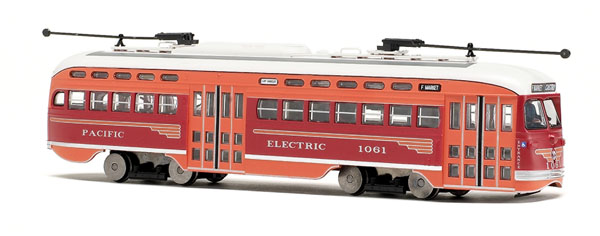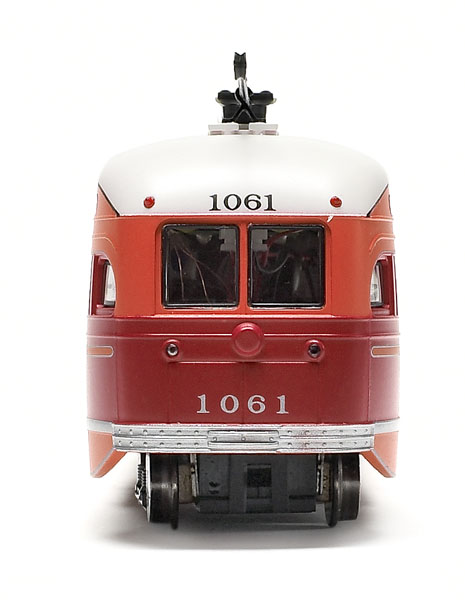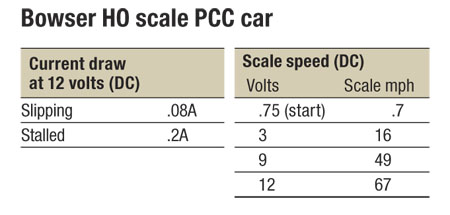Prototype. By the mid-1920s the presidents of several electric street railways in North America sought to make their companies more competitive as buses and automobiles gained prominence. These executives formed the Electric Railway Presidents Conference Committee. One result of this committee was the PCC streetcar.
More than 5,000 PCC cars were built between 1936 and 1952. The Bowser model is based on a PCC car from an order delivered by the St. Louis Car Co. to the Philadelphia Transit Co. in 1948.
In 1992, the San Francisco Municipal Ry. (Muni) acquired 15 of these PCC cars and operates them on its Market Street F Line. The Muni repainted the PCC cars in the prototypical paint schemes of other street railways that had once also run this type of car.
The dimensions of the Bowser model match drawings in PCC Cars of the United States: A Book of Plans – Variations of an American Classic (East Penn Traction Club).
The model’s plastic body shell has sharply molded details. The non-operating trolley poles are made of flexible plastic. The poles pivot but can’t be raised.
All of the windows have clear plastic glazing. The mechanism takes up most of the interior, so there isn’t a convenient way to add passenger figures. A motorman figure is included in the cab.
The trucks on the Bowser PCC car have the correct wheelbase but lack detail. Only the lower part of each truck sideframe is modeled as a separate plastic part.
The motor and flywheel are mounted on top of the frame. A worm connects the motor to a gearbox above the front truck. The wheels on the rear truck are unpowered but pick up current from the track.
A printed-circuit board (PCB) above the motor is supported by four posts attached to the frame. The PCB can be replaced by a Train Control Systems M4T Digital Command Control (DCC) decoder, which is available exclusively from Custom Traxx (See the Bowser Web site for more information).
Before running the model I applied plastic-safe light oil to the engine and wheel bearings as outlined in the instruction sheet.
The model’s non-directional headlight and taillights came on at 1.5 volts. These parts are light-emitting diodes. (The TCS M4T decoder allows you to trigger a brake light effect with function 3.)
To simulate the tight curves of a street railway, I successfully ran the Bowser PCC car on flextrack that I curved to a 7½” radius.
With its reliable drivetrain, the Bowser PCC car runs as good as it looks.
Price: $124.95
Manufacturer
Bowser Manufacturing
1302 Jordan Ave.
P.O. Box 322
Montoursville, PA 17754
www.bowser-trains.com
Road names: Pacific Electric Ry.; Baltimore Transit Co.; Boston Elevated Ry.; Brooklyn, Board of Transportation, City of New York; Chicago Transit Authority; Cincinnati Street Ry.; Kansas City Public Service Co.; Los Angeles Ry.; Louisville Ry. Co.; Newark Public Service Coordinated Transport; Philadelphia Rapid Transit; Philadelphia Transportation Co.; San Francisco Municipal Ry. (“wing” livery or later simplified paint scheme). Unpainted and undecorated version is available.
Era: 1948 to present day
Features
All-wheel electrical pickup
Can motor with brass flywheel
Metal RP-25 contour wheels in gauge
Weight: 6 ounces

















